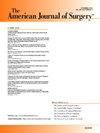从过去到现在:堪萨斯城历史上分级街区之间人际枪支暴力的比较
IF 2.7
3区 医学
Q1 SURGERY
引用次数: 0
摘要
本文章由计算机程序翻译,如有差异,请以英文原文为准。

From past to present: A comparison of interpersonal firearm violence between historically graded neighborhoods of Kansas City
Background
Interpersonal firearm violence (IFV) has been connected to the structural racism of redlining. We explored the relationship between historic redlining and IFV with population-level factors.
Methods
A cross-sectional study of IFV within historically graded neighborhoods was performed, and incidence rate ratios (IRRs) between these neighborhoods and the rate of IFV were modeled with a Poisson regression model.
Results
Comparing redlined to non-redlined neighborhoods, the IRRs adjusted for income was 14.9 (p < 0.0001), adjusted for poverty was 14.4 (p < 0.0001), adjusted for uninsured was 15.6 (p < 0.0001), and adjusted for IFV-related mortality was 26.05 (p < 0.0001). After county adjustment, every one unit increase in logarithm of income decreases the IFV rate by 64.7 % (p < 0.0001), whereas every one percent increase of poverty and uninsured, increases the IFV rates by 4.1 % (p < 0.0001) and 3.05 % (p < 0.0002), respectively.
Conclusion
Historically redlined communities have higher rates of IFV in Kansas City, Kansas.
求助全文
通过发布文献求助,成功后即可免费获取论文全文。
去求助
来源期刊
CiteScore
5.00
自引率
6.70%
发文量
570
审稿时长
56 days
期刊介绍:
The American Journal of Surgery® is a peer-reviewed journal designed for the general surgeon who performs abdominal, cancer, vascular, head and neck, breast, colorectal, and other forms of surgery. AJS is the official journal of 7 major surgical societies* and publishes their official papers as well as independently submitted clinical studies, editorials, reviews, brief reports, correspondence and book reviews.

 求助内容:
求助内容: 应助结果提醒方式:
应助结果提醒方式:


